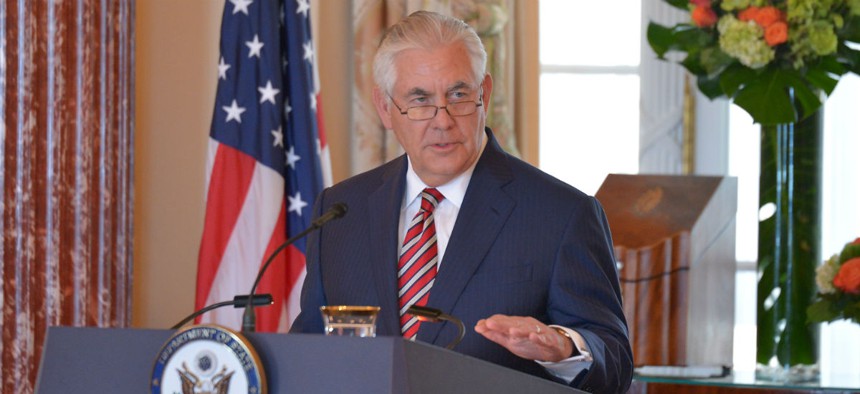
Secretary of State Rex Tillerson previewed restructuring plans in an email to staff, but employees are seeking more information. State Department
State Dept. Rebuffs Diplomats’ Plea for Release of Reorg Plan
Academy of Diplomacy’s request comes amid “water cooler” employee disgruntlement.
The State Department remains unmoved by a request this week from an association of retired diplomats that it rethink its current position and publicly release its still-evolving reorganization plan.
The nonpartisan American Academy of Diplomacy, led by ambassadors Thomas Pickering and Ronald Neumann, on Monday sent Secretary of State Rex Tillerson a letter requesting a release of the plan for public comment. “The academy, whose only interest is in strengthening American diplomacy, is already on record supporting many needed changes in the State Department’s structure and staffing,” the letter said. “Indeed, we would hope to make the academy’s extensive experience available and relevant to any conversations about the future of the department so that we might be able to support the outcome of this process.”
The letter added that the academy, like others in the Foreign Service community and in Congress, applauded Tillerson’s earlier announcement that he would fold some of State’s independent special envoys into their relevant bureaus. “Keeping your decisions from public view will only fuel the suspicion and low morale which now affects so many in the department,” the letter said.
In a statement to Government Executive on Tuesday, a State official said, “The agency reform plan submitted to [the Office of Management and Budget] is considered pre-decisional and deliberative and may not be released without prior approval from OMB.” (Government Executive has approached all the major Cabinet agencies requesting copies of their reorganization plans, but all declined for the same reason.)
Tillerson’s planned reforms—executed both in response to the governmentwide White House reorganization mandate and a Trump budget that called for steep cuts at State—have caused heartburn for many in the diplomatic community.
The secretary previewed the coming overhaul for the current staff in a Sept. 13 email, saying it would save $5 million to $10 billion in five years by curbing bureaucratic waste. As reported by Foreign Policy, Tillerson has been working with 200 State and U.S. Agency for International Development employees on recommendations such as overhauling the department’s dated information technology systems. The goal is to “align our foreign assistance and policy strategies, capabilities, and resources to meet the needs and capitalize on the opportunities of a rapidly evolving global landscape,” Tillerson’s email said.
But “some officials were put off by the buzzwords and corporate tone of the email,” Foreign Policy reported. “The missive was light on specifics, and emphasized cost savings and return on investment over the nuts-and-bolts of diplomacy, which they argue is inherently hard to monetize.” One State official confided, “It’s fluffy, meaningless B.S.”
After Tillerson’s team met with nongovernmental organization officials in August, participants reportedly described the sessions as “patronizing,” like a “1950s sex ed class.”
The blogger Diplopundit noted Tillerson’s promise to staff that “your participation is essential to a successful redesign. As the process continues, there will be more opportunities to give your input and be a part of the various execution teams as we move toward implementation. We will be asking for volunteers through the portal, and I encourage you to sign up to add your skills and talents to our effort.”
But, the retired diplomat wrote, “Tillerson has a problem, and it goes to the heart of his redesign efforts. Since employee participation is ‘essential’ to a successful redesign, it is particularly troubling that he has not directly engaged with his employees during the redesign effort in the most transparent way. He gave a couple of speeches but took no questions.” And Tillerson also shut down the two-way in-house employee forum in August.
“Folks are talking – in the cafeteria, in water coolers, in rest rooms, in online forums, etc. etc.,” Diplopundit wrote, “but they have not had the opportunity for an honest, two-way conversation about this reorganization with Secretary Tillerson.”
National security specialist James Jay Carafano offered more positive commentary in August on the website of the conservative Heritage Foundation. He interpreted the coming changes as an attempt to mimic the State Department under Secretary James Baker III in 1989-92. “What Tillerson is really trying to get at,” he wrote, is “an understanding of what the department does and doesn’t do well, why, and how that all matches up with what he wants the department to accomplish.”
He continued: “During the Obama era, the State Department responded to virtually every pet project of the administration by adding new offices, envoys and tasks. This resulted in competing offices within the State Department. Tillerson wants a State Department that is less process and churn, less advocacy and advertising, and more focused on actionable deliverables.”







